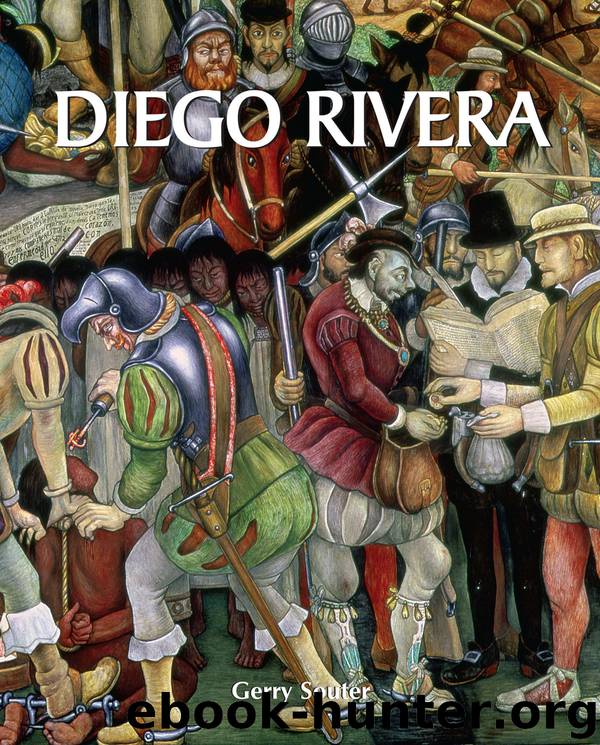Rivera by Gerry Souter

Author:Gerry Souter [Souter, Gerry]
Language: eng
Format: epub
ISBN: 9781783107759
Publisher: Parkstone International
96. José Clemente Orozco, Man of Fire, 1938-1939.
Fresco. Hospicio Cabañas, Guadalajara.
97. José Clemente Orozco, The Spanish Conquest
of Mexico – Portrait of Cortés – The Franciscan, 1938-1939.
Fresco. Hospicio Cabañas, Guadalajara.
98. Diego Rivera, Subterranean Forces, 1926-1927. Fresco,
355 x 555 cm. Universidad Autónoma de Chapingo, Chapingo.
Two mural programmes comprised the Agriculture University project: the entrance corridor, a stairwell and a second floor foyer outside the Rector’s office. The chapel faced the campus grounds and had its own entrance. It was formerly the Jesuit Convent of San Jacinto, a seventeenth-century religious community with land tilled by Indians overseen by the Jesuits. Spain expelled the Jesuits in the eighteenth century, and the land became the Hacienda de San Jacinto, a residence of the Mexican president Manuel Gonzalez. The story told by the murals was of this evolution of the land and the people it supported.
Devices employed by the Italian muralists familiar to Diego were used to show opposite points of view such as Good Government showing thriving people and well-managed land to benefit all. Bad Government, facing that panel, displays desolation and dissolution as foreign tanks and ships bombard a despoiled coastal landscape. The chapel with its Moorish exterior bell-tower circled by wrought iron railings, tiered like a layered wedding cake with clover-shaped windows circling beneath the tower’s ornamental crenellated rampart, brought redemption and victory to the common man.
Diego’s own words serve best to describe his plan for this space:
“The Chapingo frescoes are essentially a song of the land, its profundity, beauty, richness and sadness. The dominant tones are violet, green, red and orange. After it was done, I also designed the carvings for the two wooden doors at the entrance to the chapel. In the entrance hall, I depicted the four seasons of the year, the recurrent cycle in the life of the land. In the chapel itself, I represented the processes of natural evolution. The bottom wall is dominated by a large female nude, one of several symbolising ‘The Fertile Land’.”[31]
One panel, titled The Liberated Land, virtually explodes off the wall beneath the half-circular vaulted ceiling ribs rendered in faux scarlet marble inlaid with gold. Between the framing ribs, panels filled with symbolic characters are linked geometrically like Michelangelo’s Sistine Chapel in Rome. But the centrepiece is the huge pregnant nude of Guadalupe Marín. Her green cat’s eyes are so clear that she appears almost blind. In one of her huge hands rests a small plant with its leaves unfolding. She reclines above symbols of the rich earth and nature’s winds that provide not only food, but ore and flame to create steel for industry. Further nudes represent the Mexican people who receive these gifts. More panels march down the side walls and above them sunbursts frame the round windows, and the bodies of Mexico’s revolutionary martyrs lie beneath the earth fertilising the green corn that feeds the people.
Of course, Diego asked Tina Modotti to pose for the sketches he would use to create some of the murals’ mythical characters and symbols. The
Download
This site does not store any files on its server. We only index and link to content provided by other sites. Please contact the content providers to delete copyright contents if any and email us, we'll remove relevant links or contents immediately.
The Art of Boudoir Photography: How to Create Stunning Photographs of Women by Christa Meola(18581)
Red Sparrow by Jason Matthews(5424)
Harry Potter 02 & The Chamber Of Secrets (Illustrated) by J.K. Rowling(3646)
In a Sunburned Country by Bill Bryson(3506)
Drawing Cutting Edge Anatomy by Christopher Hart(3484)
Figure Drawing for Artists by Steve Huston(3409)
Harry Potter and the Prisoner of Azkaban (Book 3) by J. K. Rowling(3323)
The Daily Stoic by Holiday Ryan & Hanselman Stephen(3264)
Japanese Design by Patricia J. Graham(3137)
The Roots of Romanticism (Second Edition) by Berlin Isaiah Hardy Henry Gray John(2887)
Make Comics Like the Pros by Greg Pak(2881)
Stacked Decks by The Rotenberg Collection(2841)
Draw-A-Saurus by James Silvani(2686)
Harry Potter and the Deathly Hallows (7) by J.K. Rowling(2679)
Tattoo Art by Doralba Picerno(2622)
On Photography by Susan Sontag(2607)
Churchill by Paul Johnson(2542)
The Daily Stoic by Ryan Holiday & Stephen Hanselman(2522)
Drawing and Painting Birds by Tim Wootton(2474)
